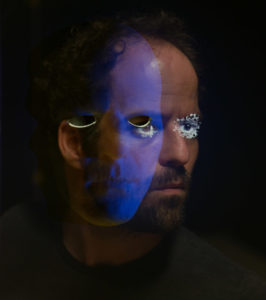In his studio-laboratory, Stéphane Gladyszewski conducts ‘technorganic’ experiments through which he attempts to reveal the hidden part of our multiform corporeality. Situated at the crossroads between performance, visual, and digital arts, his work seeks to explore the limits of perception. The technological tools that he has developed are deployed to complicate and problematize the tangible real, in order to go beyond the boundaries of objects and bodies. Initially interested in the body, images, and light, Stéphane Gladyszewski studied and worked in photography before completing his B.F.A. in fine arts (Université du Québec à Montréal – UQAM), Concordia University).
Vertébré – 2002 (sculpture)
Vertebra sprung from Gladyszewki’s interest in the articulation and functioning of the spinal cord and undulatory movement. Wanting to create a tail, or extension of the spine to move from and with, he began by closely examining the physiology of the neck of the ostrich, and enriched it with a study of nautical knots. The latex was woven such that the same tension projected from one end to the other: held in one hand, the column extended horizontally on its own. Once constructed, Vertebra became an object or artifact which accompanied Gladyszewki in elaborating the choregraphies for Aura and Corps noir. It stimulated his imaginary, and also served as a tool for interaction. Vertebra was, in the artist’s own words, “The column around which I first built the flesh of my choreography.”
AB OVO – 2002 (installation/sculpture)
The end of Gladyszewski’s journey of discovery around a source of ceaseless fascination: Asclepias syriaca, more commonly known as the milkweed pod. Exhaustive research and experimentation with the properties of the pods in their various stages of maturation led to the creation of this large-scale installation which reenacted, in three stages, the ‘lifecycle’ of the pods as they blossomed and matured.
Entering the space, viewers were invited to initiate the cycle for a pod that they found under the heavy steel lid of a refrigeration chamber (images 2, 3). They could then place it in the incubator (image 4), a heated wooden chamber which warmed the pods and blew the seeds outside. Finally, viewers could wander around the cavernous space, filled with clouds and waves of silk filament and seeds at rest (images 5 & 6). A meditation on transformation, maturation, and the transience of life’s processes, from the thermal exchange of heat, to the birth or rebirth out of our ‘shells’.
CORPS NOIR – 2008 (choreography)
Corps noir is a raw immersion in intimacy. The human body staged in a mad collection of props and objects representing a variety of textures, resonant materials, images and voices, like so many metaphors of identity relayed by a state-of-the-art technology that allows for superimposing, embedding, and fusing. This bazaar of the subconscious and of memory presents the reassembled, disjointed or dislocated pieces of a fictitious self that lies somewhere between solid and liquid, frosted screens, ice and water, warmth and cold, obtuseness and transparency. The human body is dragged in to be soaked, soiled, and absorbed…and joins the fray fighting, penetrating, but also embracing. And radiating. In this work,the artist chooses to become the medium of the message, to expose his inner self and to produce an exploded self-portrait based on the complexity of a star-studded identity and the phantasmagorical constructions of the psyche.
TÊTE À TÊTE – 2012 (Installation/performance)
Like a little cosmos taken from a Renaissance painting and bathed in chiaroscuro, Alone Together is an experiential work halfway between object theatre, optical installation and existential tale. To experience it, the spectator must tuck his or her face inside a mask imbedded in a bare wall. The mask, in fact, is an exact copy of the face of the artist (and performer) through which the spectator looks as if through a keyhole. By blending their faces with that of the performer, the spectators watch as a scene involving a man and a variety of organic matter (firebrand, fire, rice paper, plaster mask, apple) plays out before them.
Equipped with a headset connected to an ambient sound system, the spectator is plunged into an immersive sound environment in which a young boy whispers the words of the poet Octavio Paz, “two bodies face to face (…).” According to the principles of anamorphosis, the single viewpoint offered to the watcher allows the artist to work the light and perspective of these living tableaus into a perfect trompe l’œil. Using carefully calibrated lighting and high-precision optical elements, the spectator is made to face his or her own holographic reflection; as though invited to “come into my head,” the spectator travels and slides between several layers of identity. The spectator is then unmasked. In the end, artist and spectator literally merge, as the artist enters the spectator’s skin, gaze and expressions. Two faces blend together to create a third face. The illusion of being penetrated and inhabited by a foreign body is created. We walk out in silence, wondering whether we were truly touched… And yet we were – with just the fingertips.






